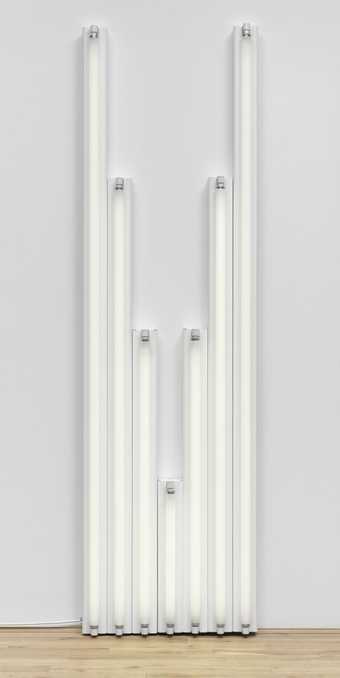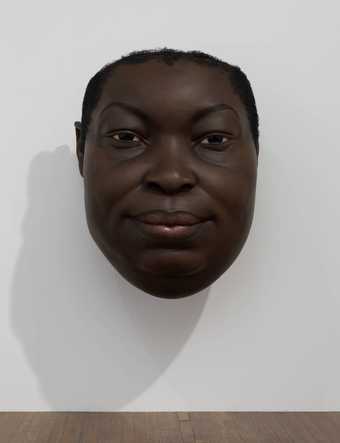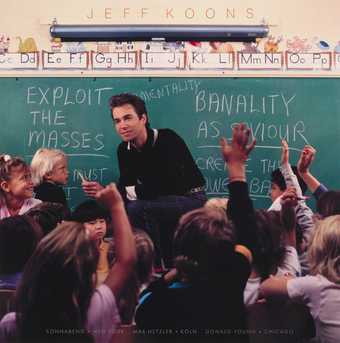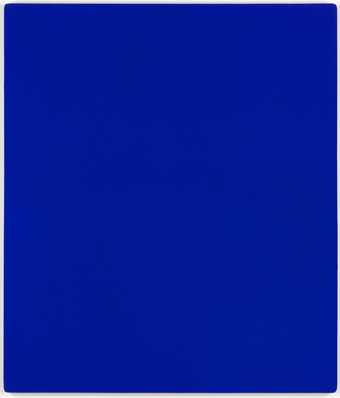
Robert Therrien Red Room 2000–2007
© Robert Therrien
Introduction
By experimenting with materials, techniques and scale, Robert Therrien shows ua everyday objects in a new light. He reveals their hidden narratives and drama, and explores the physical and emotional connection we have with the things that help us to live our lives. These ordinary objects, as recreated by Therrien, trigger memories and a sense of nostalgia, as well as humour and magic. Although familiar, they can also appear mysterious and unsettling.
Through artworks from the ARTIST ROOMS collection, take a closer look at how Robert Therrien explores the power of simple objects and images.
Found Objects and Stories: Red Room
Robert Therrien’s installation RED ROOM is a cupboard-sized room filled with 888 red objects collected by the artist. Some of the objects have been manufactured in red materials while others have been painted red. Therrien first started collecting red objects when he was sent samples of red plastics. He stores his red objects in a cupboard in his studio. For RED ROOM, he recreates this cupboard using its dimensions for his installation. The objects, which range from kitchen utensils and building materials to clothing and electrical appliances, are so tightly packed in to the room they seem to merge together and look like a large monochrome painting.
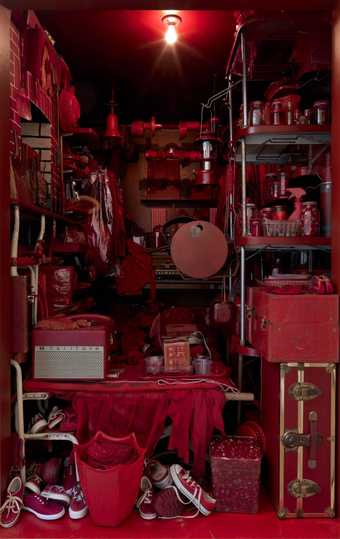
Robert Therrien
RED ROOM (2000–7)
ARTIST ROOMS Tate and National Galleries of Scotland
Although the collection of objects at first seems random, if we look closer we can see that each object has been carefully chosen and positioned. Many of the objects are significant to Therrien. They either relate to his own past, to his friends and family, or to his art- making. He places the things that are personal to him, such as his brother’s summer-camp sweatshirt, alongside more generic things. This blend of the personal with the general, and the everyday with the unreal suggests an underlying story. Therrien said that when he was creating the room he ‘began to imagine that a family might live here: a father, a mother, and two children, all with red hair, of course’. The electrical appliances – which include an organ, a radio, a telephone, a wall clock and a quesadilla grill – are all in working order, so that these imagined inhabitants can make use of them.
Found objects
Robert Therrien’s use of everyday objects and existing images relates back to artist Marcel Duchamp at the beginning of the twentieth century. Duchamp used manufactured objects as his artworks, calling them 'readymades'. Therrien's interest in the subject matter of normal, American life and household objects such as a coffee pot and a scrubbing brush, also makes us think of pop art. In the 1950s and 1960s pop artists made art about ordinary life and the things that people bight into their homes.
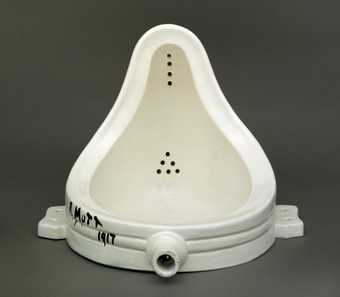
Marcel Duchamp
Fountain (1917, replica 1964)
Tate
© Succession Marcel Duchamp/ADAGP, Paris and DACS, London 2025
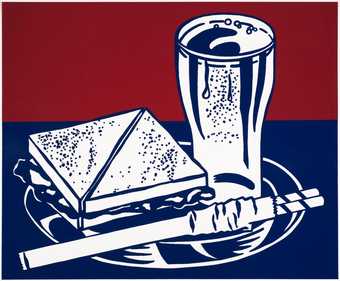
Roy Lichtenstein
Sandwich and Soda (1964)
Tate
Larger than Life
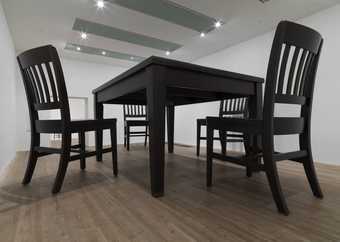
Robert Therrien
No Title (Table and Four Chairs) (2003)
ARTIST ROOMS Tate and National Galleries of Scotland
Therrien’s sculptures are often based on functional, mass-produced objects such as chairs, tables, saucepans and other kitchenware. By celebrating these objects he seems to conjure up the decades after the Second World War when the American economy was booming. In the 1950s the USA became associated with consumerism and home comforts, as well as conformity (everyone wanting the same newest, latest things in their home).

Robert Therrien
No Title (Stacked Plates) (2010)
ARTIST ROOMS Tate and National Galleries of Scotland
The sculpture No Title (Stacked Plates) 2010 looks exactly like an ordinary mass-produced stack of plates – except the plates are gigantic! The enlarged scale and what looks like precarious stacking of the plates makes viewing the sculpture slightly disturbing. Therrien is perhaps making us think about our consumerist obsession with things and how these can take over our lives. The experience of looking at the huge plates also reminds us of childhood stories; making us think of Jonathan Swift’s Gulliver’s Travels 1726 or Lewis Carroll’s Alice in Wonderland 1865.
Music, Dancing and Nostalgia
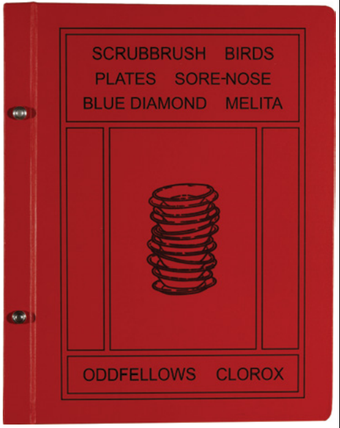
Robert Therrien Cover of Scrubbrush Bird Book, RED ROOM 2000-7
© Robert Therrien
Scrubbrush Bird Book is one of the objects in Therrien’s installation RED ROOM. Its pages feature a series of drawings, photographs and prints of images and motifs that Therrien uses again and again in his work. On the red cover of the book is a drawing of his stacked plates.
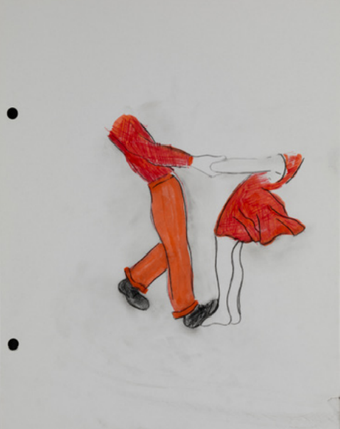
Robert Therrien Dancing Couple, RED ROOM 2000-7
© Robert Therrien
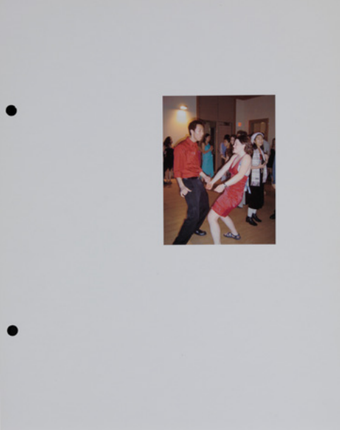
Robert Therrien Red Hot (Shirt) Couple, RED ROOM 2000-7
© Robert Therrien
Dancing Couple is a drawing of a dancing couple in profile. They could be on a first date, perhaps attending a high school dance. But their story and emotions remain a mystery as they are shown isolated and their heads are missing. The couple’s clothing and style of their dance suggests the 1950s. The male dancer seems to be standing on his female partner’s foot, and the dance looks awkward.
Red Hot (Shirt) Couple – another page from Scrubbrush Bird Book – also shows a dancing couple. But this time we see the couple’s faces, other dancers, and the venue itself. The venue appears to be a multi-purpose function space rather than a nightclub which suggests a family or social event.
Both Dancing Couple and Red Hot (Shirt) Couple are playful images. The awkward dance makes us perhaps remember our own memories of awkward first dates. The couple are dressed mainly in red; a colour often associated with danger but also passion.
Therrien re-uses the theme of music and dancing in Red Records (another RED ROOM object). This is a photographic image of vinyl records, again suggesting an earlier era. We associate vinyl with the 1950s and 1960s when there was an explosion of rock and roll music and youth culture.
A Touch of Magic: Red Shoes
One of the pages in Scrubbrush Bird Book, shows three different photographs of red shoes. These increase in size as they cascade down from the top to the bottom of the page. We also see some of these shoes in Therrien's installation RED ROOM.

Photograph of Red Bench Room, Sculpture 1991, RED ROOM 2000-7
© Robert Therrien
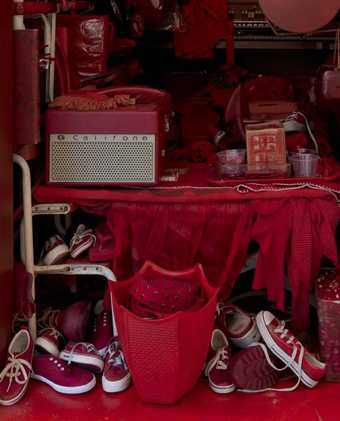
Detail of Robert Therrien's RED ROOM 2000–7
© Robert Therrien
Although these red shoes look very ordinary, (actually kind of scruffy!), red shoes often have associations with the magical in popular culture. In Hans Christian Anderson's fairy tale The Red Shoe 1845 and the children’s novel The Wonderful Wizard of Oz 1902 red shoes give their wearers special powers. In Hans Christian Anderson’s fairytale, the ballerina Karen can’t stop dancing when she wears the red shoes and in the Wizard of Oz, Dorothy needs to find her ruby slippers before she can return home.
Cartoons, Stencils and Outlines
Robert Therrien often uses stencils to create his drawings. By using stencils he can make lots of different versions of the same basic image. Each image has slight alterations and, although they seem familar partly because of their repetition, their meaning is ambiguous. Therrien has said that his love of using stencils to create simple outline drawings comes from childhood.
As a child I had a stencil kit which might explain my attraction to linear edge and flat silhouettes. I still have it, as well as a collection of architectural templates; and I still use it as well as a collection of various other templates.
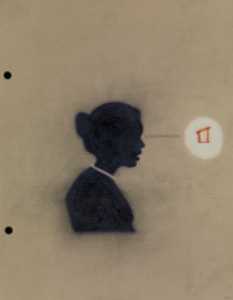
Robert Therrien An Eye for Real Estate, RED ROOM 2000-7
© Robert Therrien

Robert Therrien Sore Nose, RED ROOM 2000-7
© Robert Therrien

Robert Therrien An Image of Scolding Hand, RED ROOM 2000-7
© Robert Therrien
Eye for Real Estate shows a profile silhouette of a woman’s head and shoulders. The silhouette motif and sepia colour of the paper make it look old fashioned. Profile silhouettes were popular in the eighteenth century before photography was invented. But by including a dotted line from the figure’s eyes Therrien updates the image. A dotted line is often used in cartoons and comic strips to suggest what a character might be thinking about. The figure looks towards a mysterious symbol that looks a bit like the simplified shape of a building.
Therrien also uses a silhouette in An Image of Scolding Hand. A cartoon-like head in profile is placed against a dense red background. A hand with a finger points towards the face and mouth of the cartoon figure adding a sense of surreal humour to the work. The same cartoon-like head reappears in lots of Therrien’s works on paper. In Sore Nose the head motif is an outline. It is slightly different from other versions of the head: the mouth of the head is open and the nose is red, suggesting its soreness. The playful imagery is repeated in another more detailed, cartoonlike portrait in the centre of the drawing – a figure that looks a bit like Velma from the cartoon Scooby-Doo.
Mystery and Meaning: Mixing Motifs
In his sculptures and drawings, Therrien often uses the same motif to suggest different things. This creates an interaction between his work, their shapes, and the objects they relate to. It also makes the meaning of his work hard to grasp and mysterious.
Therrien's drawing [no title] 1995 looks a church, the type of typical rural church you might find in the American West. (He uses the same shape in another drawing that has Chapel as its title). But the shape is also similar to the shape of sculptures by Therrien such as his oil cans and bent cones. It becomes a shape that symbolises very different aspects of American Culture.
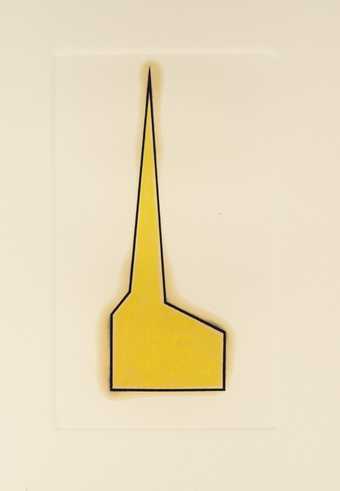
Robert Therrien
[no title] (1995)
Tate
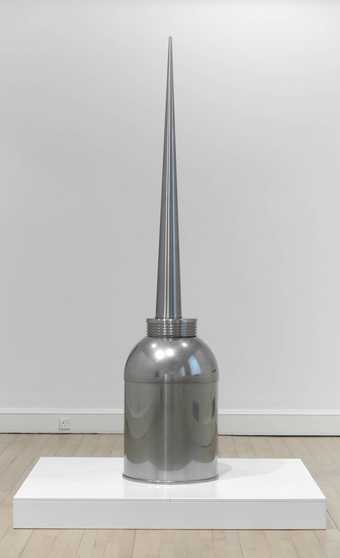
Robert Therrien
No Title (Oil Can) (2004)
ARTIST ROOMS Tate and National Galleries of Scotland
In the sculpture Untitled (Oil Can) 2004 Therrien exaggerates the scale of a mass-produced oil can. We are reflected in its polished surface. Dwarfed by the oversized structure, we can't help think about the function of such a simple object and how we see ourselves in relation to it. The oil can perhaps references the American automobile industry and perhaps an earlier time when American production of automobiles was the largest in the world.
This untitled drawing from 1995 shows a construction made of beams of wood that look like gallows – the wooden frame used to execute people by hanging.

Robert Therrien
[no title] (1995)
Tate
But as well as being a rather dark symbol; the motif of the gallows drawn on paper also suggests the paper and pencil guessing game Hangman which originated in the Victorian times. In the game, one player thinks of a word, phrase or sentence and the other tries to guess it by suggesting letters or numbers.
This double-edged motif which references a game at the same time as gallows, sums up the elusive unsettling nature of Therrien's work. The ordinary is sometimes magical, nostalgic and funny, the everyday can be dramatic and unsettling, and what appear to be simple, familiar shapes and motifs aren't always what they seem.

